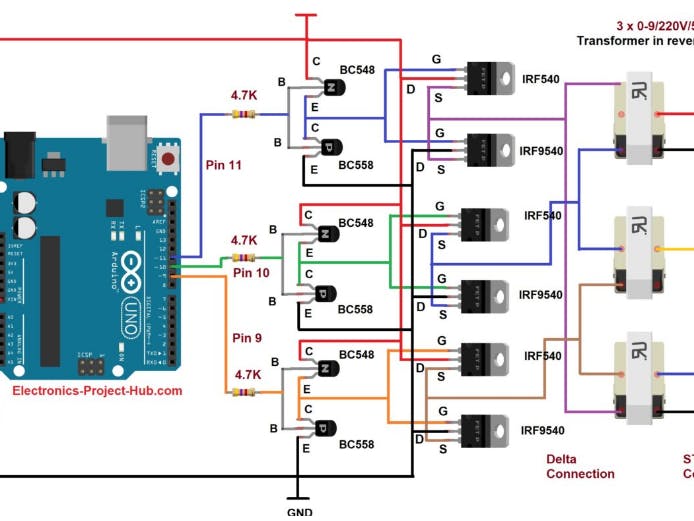In this post we are going to construct a three-phase inverter circuit using Arduino and MOSFET. We will have a brief look at the three phase transformer working and we will construct a three phase transformer using three “single phase transformer” by combining the windings in delta and start connections. We will also take a look at the wave form generated by Arduino.
We will see:- Circuit Diagram.
- Circuit Description.
- Program code for Arduino.
- Three phase waveform generated by Arduino.
- Push-Pull MOSFET stage.
- Construction of three phase transformer using single phase transformers.
- Advantage and disadvantage of this three phase inverter circuit.
Program CodeFor 3 Phase Inverter Circuit:
- The circuit consists of an Arduino which generates the 3 phase waveform with 120degree electrical phase difference between each individual waveform. You may use your favorite Arduino board.
- The BJTs and MOSFETs are configured in push-pull configuration; three push-pull stages are utilized for three individual phases.
- Three single phase step-down transformers (used in reverse) are connected in delta and star connection at primary and secondary winding respectively; this will replicate a three phase transformer.
- At the output we have three phases and one neutral line derived by using star connection at secondary side.
- We have used three 0-9V transformer and all must be at-least 5A rated to get a decent power output.
- A fuse is included in the circuit to prevent short-circuit due to some unfortunate situations that may occur.
Related :Single and Three-Phase Power: What Are Features and Differences?
Program CodeFor 3 Phase Inverter Circuit:
All three phases are shifted 120 degree electrically with each individual phase and yes, this is not a pure sine wave type.
The above wave-forms are generated by Arduino at pins 9, 10and 11. The last two waveforms are moved downwards on the oscilloscope, so that the waveform don’t overlap each other and we can compare the wave-forms.
To get a clear idea we have marked the waveform so that we can see the 120 degree phase shift in the wave from.
As we can see that each waveform are 120 degree electrically shifted from each other. The generated three phase signal cannot be applied directly to the transformer to step-up; to do this the three phase signals are applied to a buffer stage which consists of BJTs and MOSFETs.
All the three phase signals are 50Hz and 50% duty cycle with respect to ground.Push-Pull MOSFET Driver Stage:The feeble three phase signals are pre-amplified by a couple of low power BJTs per phase signal. The BJT is configured in push-pull configuration so that it can amplify both LOW and HIGH signals; now three such push-pull stages are implemented in the circuit.
he output signal from BJT is inverted by 180 degree from the applied signal (for all three phases). The 5V signal from Arduino is now amplified to 12V signal which is sufficient for a MOSFETs to turn ON and OFF(fully). If we directly apply the 5V signal from Arduino to gate of the MOSFET, the MOSFET will still switch ON and OFF (partially) but there will be huge resistance between source and drain terminal which will not allow maximum current to flow and cause MOSFETs to overheat
Now the 12V (from BJTs) signal is applied to MOSFETs which is also configured in push-pull. The output at the MOSFET is now a strong which can drive the three phase transformer. The output signal from the MOSFET is 180 degree inverted (again) from the BJT’s output, now we got zero degree phase shift with respect to Arduino’s output. The weak signal from the Arduino is now on the steroid with exactly same phase difference etc.
Construction of Three Phase Transformer Using Three Single Phase Transformer:Now here is the most interesting part of the project, we are going to construct a three phase transformer using three individual ordinary step-down transformers.
We can take three single phase transformers and connect their primary windings each other and secondary windings each other in star or delta configuration or one of the windings in star and other in delta configuration, now we can use it with three phase supply.
In this case the output is configured in “star” with a neutral point taken from the center of the star connection, while the other side of transformer is connected in delta configuration as illustrated below:




Comments
Please log in or sign up to comment.